Aydogan Ozcan
Universal point spread function engineering for 3D optical information processing
Feb 09, 2025Abstract:Point spread function (PSF) engineering has been pivotal in the remarkable progress made in high-resolution imaging in the last decades. However, the diversity in PSF structures attainable through existing engineering methods is limited. Here, we report universal PSF engineering, demonstrating a method to synthesize an arbitrary set of spatially varying 3D PSFs between the input and output volumes of a spatially incoherent diffractive processor composed of cascaded transmissive surfaces. We rigorously analyze the PSF engineering capabilities of such diffractive processors within the diffraction limit of light and provide numerical demonstrations of unique imaging capabilities, such as snapshot 3D multispectral imaging without involving any spectral filters, axial scanning or digital reconstruction steps, which is enabled by the spatial and spectral engineering of 3D PSFs. Our framework and analysis would be important for future advancements in computational imaging, sensing and diffractive processing of 3D optical information.
Snapshot multi-spectral imaging through defocusing and a Fourier imager network
Jan 24, 2025



Abstract:Multi-spectral imaging, which simultaneously captures the spatial and spectral information of a scene, is widely used across diverse fields, including remote sensing, biomedical imaging, and agricultural monitoring. Here, we introduce a snapshot multi-spectral imaging approach employing a standard monochrome image sensor with no additional spectral filters or customized components. Our system leverages the inherent chromatic aberration of wavelength-dependent defocusing as a natural source of physical encoding of multi-spectral information; this encoded image information is rapidly decoded via a deep learning-based multi-spectral Fourier Imager Network (mFIN). We experimentally tested our method with six illumination bands and demonstrated an overall accuracy of 92.98% for predicting the illumination channels at the input and achieved a robust multi-spectral image reconstruction on various test objects. This deep learning-powered framework achieves high-quality multi-spectral image reconstruction using snapshot image acquisition with a monochrome image sensor and could be useful for applications in biomedicine, industrial quality control, and agriculture, among others.
Virtual Staining of Label-Free Tissue in Imaging Mass Spectrometry
Nov 20, 2024



Abstract:Imaging mass spectrometry (IMS) is a powerful tool for untargeted, highly multiplexed molecular mapping of tissue in biomedical research. IMS offers a means of mapping the spatial distributions of molecular species in biological tissue with unparalleled chemical specificity and sensitivity. However, most IMS platforms are not able to achieve microscopy-level spatial resolution and lack cellular morphological contrast, necessitating subsequent histochemical staining, microscopic imaging and advanced image registration steps to enable molecular distributions to be linked to specific tissue features and cell types. Here, we present a virtual histological staining approach that enhances spatial resolution and digitally introduces cellular morphological contrast into mass spectrometry images of label-free human tissue using a diffusion model. Blind testing on human kidney tissue demonstrated that the virtually stained images of label-free samples closely match their histochemically stained counterparts (with Periodic Acid-Schiff staining), showing high concordance in identifying key renal pathology structures despite utilizing IMS data with 10-fold larger pixel size. Additionally, our approach employs an optimized noise sampling technique during the diffusion model's inference process to reduce variance in the generated images, yielding reliable and repeatable virtual staining. We believe this virtual staining method will significantly expand the applicability of IMS in life sciences and open new avenues for mass spectrometry-based biomedical research.
Leveraging Computational Pathology AI for Noninvasive Optical Imaging Analysis Without Retraining
Nov 19, 2024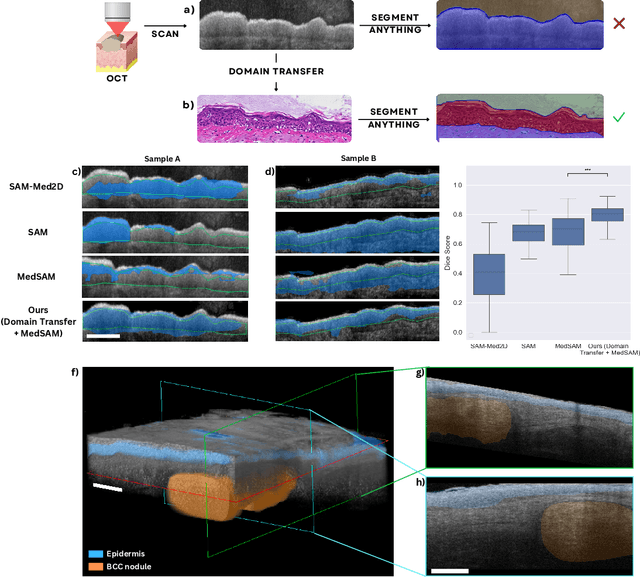
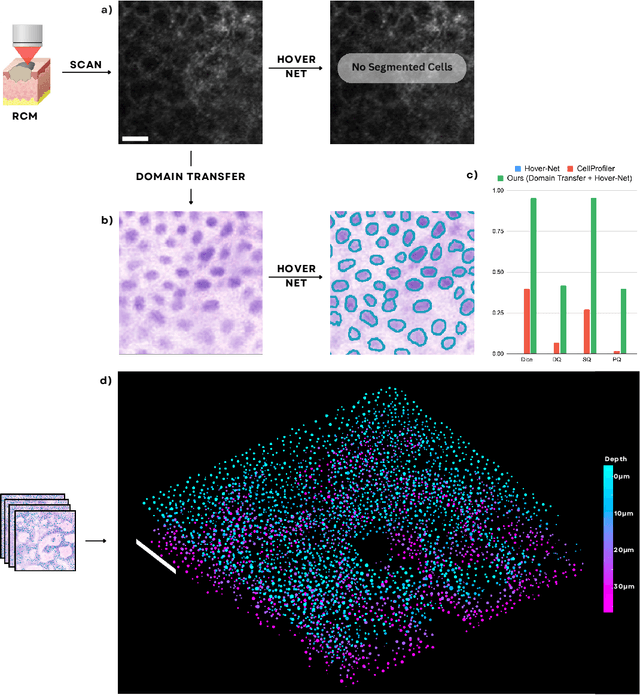
Abstract:Noninvasive optical imaging modalities can probe patient's tissue in 3D and over time generate gigabytes of clinically relevant data per sample. There is a need for AI models to analyze this data and assist clinical workflow. The lack of expert labelers and the large dataset required (>100,000 images) for model training and tuning are the main hurdles in creating foundation models. In this paper we introduce FoundationShift, a method to apply any AI model from computational pathology without retraining. We show our method is more accurate than state of the art models (SAM, MedSAM, SAM-Med2D, CellProfiler, Hover-Net, PLIP, UNI and ChatGPT), with multiple imaging modalities (OCT and RCM). This is achieved without the need for model retraining or fine-tuning. Applying our method to noninvasive in vivo images could enable physicians to readily incorporate optical imaging modalities into their clinical practice, providing real time tissue analysis and improving patient care.
Super-resolved virtual staining of label-free tissue using diffusion models
Oct 26, 2024Abstract:Virtual staining of tissue offers a powerful tool for transforming label-free microscopy images of unstained tissue into equivalents of histochemically stained samples. This study presents a diffusion model-based super-resolution virtual staining approach utilizing a Brownian bridge process to enhance both the spatial resolution and fidelity of label-free virtual tissue staining, addressing the limitations of traditional deep learning-based methods. Our approach integrates novel sampling techniques into a diffusion model-based image inference process to significantly reduce the variance in the generated virtually stained images, resulting in more stable and accurate outputs. Blindly applied to lower-resolution auto-fluorescence images of label-free human lung tissue samples, the diffusion-based super-resolution virtual staining model consistently outperformed conventional approaches in resolution, structural similarity and perceptual accuracy, successfully achieving a super-resolution factor of 4-5x, increasing the output space-bandwidth product by 16-25-fold compared to the input label-free microscopy images. Diffusion-based super-resolved virtual tissue staining not only improves resolution and image quality but also enhances the reliability of virtual staining without traditional chemical staining, offering significant potential for clinical diagnostics.
BlurryScope: a cost-effective and compact scanning microscope for automated HER2 scoring using deep learning on blurry image data
Oct 23, 2024Abstract:We developed a rapid scanning optical microscope, termed "BlurryScope", that leverages continuous image acquisition and deep learning to provide a cost-effective and compact solution for automated inspection and analysis of tissue sections. BlurryScope integrates specialized hardware with a neural network-based model to quickly process motion-blurred histological images and perform automated pathology classification. This device offers comparable speed to commercial digital pathology scanners, but at a significantly lower price point and smaller size/weight, making it ideal for fast triaging in small clinics, as well as for resource-limited settings. To demonstrate the proof-of-concept of BlurryScope, we implemented automated classification of human epidermal growth factor receptor 2 (HER2) scores on immunohistochemically (IHC) stained breast tissue sections, achieving concordant results with those obtained from a high-end digital scanning microscope. We evaluated this approach by scanning HER2-stained tissue microarrays (TMAs) at a continuous speed of 5 mm/s, which introduces bidirectional motion blur artifacts. These compromised images were then used to train our network models. Using a test set of 284 unique patient cores, we achieved blind testing accuracies of 79.3% and 89.7% for 4-class (0, 1+, 2+, 3+) and 2-class (0/1+ , 2+/3+) HER2 score classification, respectively. BlurryScope automates the entire workflow, from image scanning to stitching and cropping of regions of interest, as well as HER2 score classification. We believe BlurryScope has the potential to enhance the current pathology infrastructure in resource-scarce environments, save diagnostician time and bolster cancer identification and classification across various clinical environments.
Optical Generative Models
Oct 23, 2024Abstract:Generative models cover various application areas, including image, video and music synthesis, natural language processing, and molecular design, among many others. As digital generative models become larger, scalable inference in a fast and energy-efficient manner becomes a challenge. Here, we present optical generative models inspired by diffusion models, where a shallow and fast digital encoder first maps random noise into phase patterns that serve as optical generative seeds for a desired data distribution; a jointly-trained free-space-based reconfigurable decoder all-optically processes these generative seeds to create novel images (never seen before) following the target data distribution. Except for the illumination power and the random seed generation through a shallow encoder, these optical generative models do not consume computing power during the synthesis of novel images. We report the optical generation of monochrome and multi-color novel images of handwritten digits, fashion products, butterflies, and human faces, following the data distributions of MNIST, Fashion MNIST, Butterflies-100, and Celeb-A datasets, respectively, achieving an overall performance comparable to digital neural network-based generative models. To experimentally demonstrate optical generative models, we used visible light to generate, in a snapshot, novel images of handwritten digits and fashion products. These optical generative models might pave the way for energy-efficient, scalable and rapid inference tasks, further exploiting the potentials of optics and photonics for artificial intelligence-generated content.
Lying mirror
Oct 20, 2024



Abstract:We introduce an all-optical system, termed the "lying mirror", to hide input information by transforming it into misleading, ordinary-looking patterns that effectively camouflage the underlying image data and deceive the observers. This misleading transformation is achieved through passive light-matter interactions of the incident light with an optimized structured diffractive surface, enabling the optical concealment of any form of secret input data without any digital computing. These lying mirror designs were shown to camouflage different types of input image data, exhibiting robustness against a range of adversarial manipulations, including random image noise as well as unknown, random rotations, shifts, and scaling of the object features. The feasibility of the lying mirror concept was also validated experimentally using a structured micro-mirror array along with multi-wavelength illumination at 480, 550 and 600 nm, covering the blue, green and red image channels. This framework showcases the power of structured diffractive surfaces for visual information processing and might find various applications in defense, security and entertainment.
Deep Learning-based Detection of Bacterial Swarm Motion Using a Single Image
Oct 19, 2024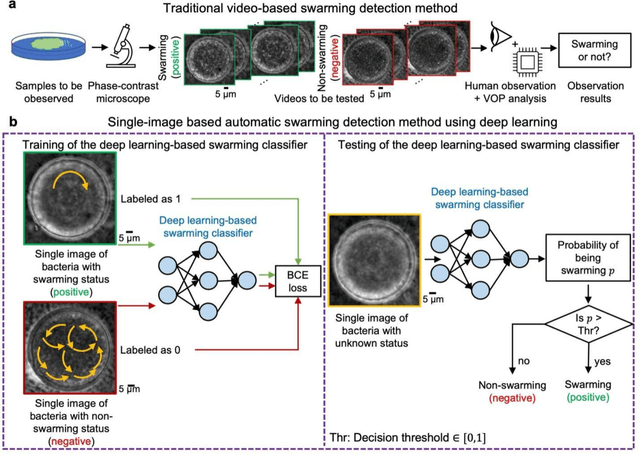
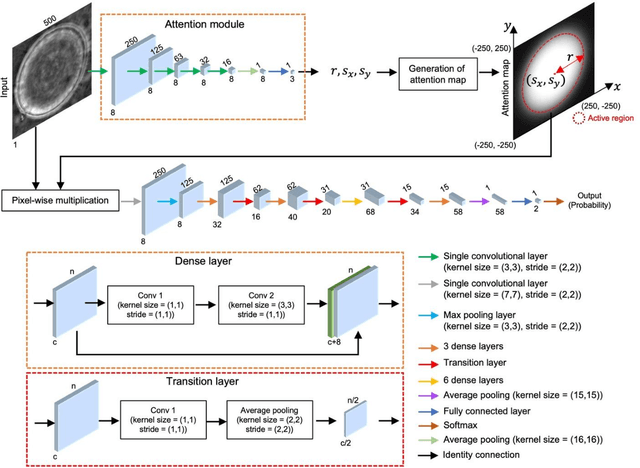
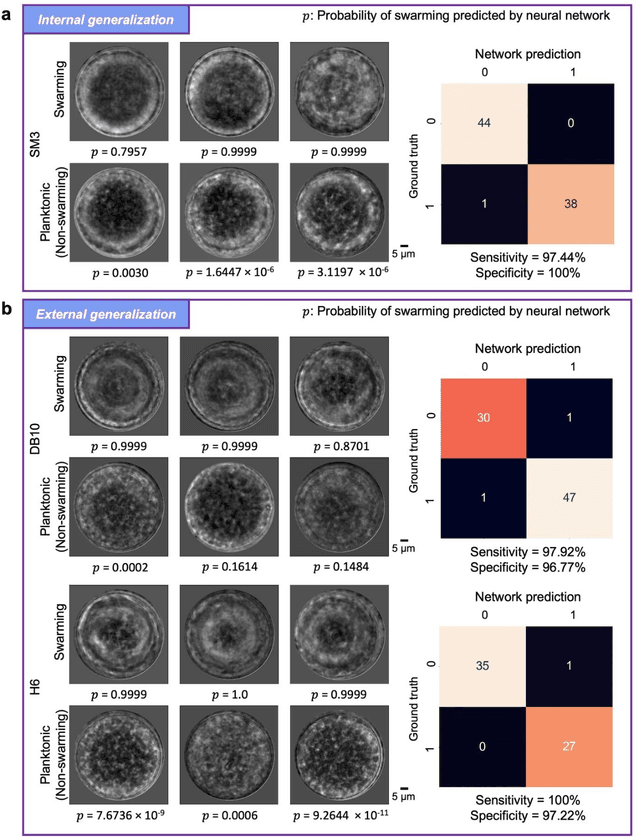
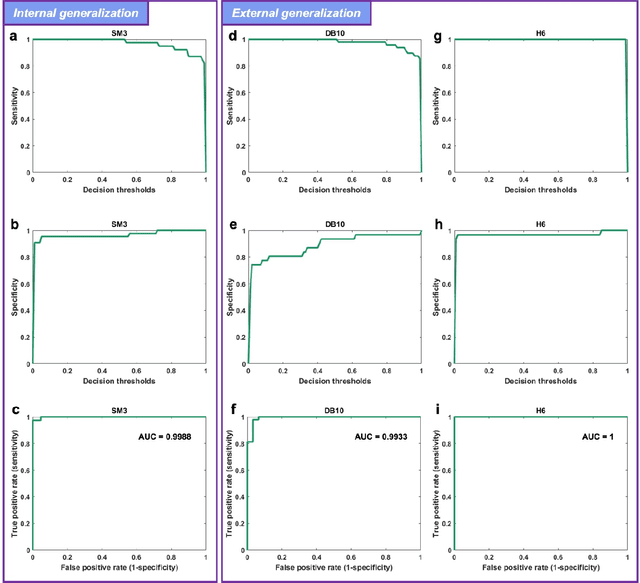
Abstract:Distinguishing between swarming and swimming, the two principal forms of bacterial movement, holds significant conceptual and clinical relevance. This is because bacteria that exhibit swarming capabilities often possess unique properties crucial to the pathogenesis of infectious diseases and may also have therapeutic potential. Here, we report a deep learning-based swarming classifier that rapidly and autonomously predicts swarming probability using a single blurry image. Compared with traditional video-based, manually-processed approaches, our method is particularly suited for high-throughput environments and provides objective, quantitative assessments of swarming probability. The swarming classifier demonstrated in our work was trained on Enterobacter sp. SM3 and showed good performance when blindly tested on new swarming (positive) and swimming (negative) test images of SM3, achieving a sensitivity of 97.44% and a specificity of 100%. Furthermore, this classifier demonstrated robust external generalization capabilities when applied to unseen bacterial species, such as Serratia marcescens DB10 and Citrobacter koseri H6. It blindly achieved a sensitivity of 97.92% and a specificity of 96.77% for DB10, and a sensitivity of 100% and a specificity of 97.22% for H6. This competitive performance indicates the potential to adapt our approach for diagnostic applications through portable devices or even smartphones. This adaptation would facilitate rapid, objective, on-site screening for bacterial swarming motility, potentially enhancing the early detection and treatment assessment of various diseases, including inflammatory bowel diseases (IBD) and urinary tract infections (UTI).
Label-free evaluation of lung and heart transplant biopsies using virtual staining
Sep 09, 2024



Abstract:Organ transplantation serves as the primary therapeutic strategy for end-stage organ failures. However, allograft rejection is a common complication of organ transplantation. Histological assessment is essential for the timely detection and diagnosis of transplant rejection and remains the gold standard. Nevertheless, the traditional histochemical staining process is time-consuming, costly, and labor-intensive. Here, we present a panel of virtual staining neural networks for lung and heart transplant biopsies, which digitally convert autofluorescence microscopic images of label-free tissue sections into their brightfield histologically stained counterparts, bypassing the traditional histochemical staining process. Specifically, we virtually generated Hematoxylin and Eosin (H&E), Masson's Trichrome (MT), and Elastic Verhoeff-Van Gieson (EVG) stains for label-free transplant lung tissue, along with H&E and MT stains for label-free transplant heart tissue. Subsequent blind evaluations conducted by three board-certified pathologists have confirmed that the virtual staining networks consistently produce high-quality histology images with high color uniformity, closely resembling their well-stained histochemical counterparts across various tissue features. The use of virtually stained images for the evaluation of transplant biopsies achieved comparable diagnostic outcomes to those obtained via traditional histochemical staining, with a concordance rate of 82.4% for lung samples and 91.7% for heart samples. Moreover, virtual staining models create multiple stains from the same autofluorescence input, eliminating structural mismatches observed between adjacent sections stained in the traditional workflow, while also saving tissue, expert time, and staining costs.
 Add to Chrome
Add to Chrome Add to Firefox
Add to Firefox Add to Edge
Add to Edge